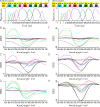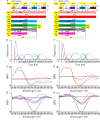Reaction Dynamics in the Chrimson Channelrhodopsin: Observation of Product-State Evolution and Slow Diffusive Protein Motions
- PMID: 36745035
- PMCID: PMC9940203
- DOI: 10.1021/acs.jpclett.2c03110
Reaction Dynamics in the Chrimson Channelrhodopsin: Observation of Product-State Evolution and Slow Diffusive Protein Motions
Abstract
Chrimson is a red-light absorbing channelrhodopsin useful for deep-tissue optogenetics applications. Here, we present the Chrimson reaction dynamics from femtoseconds to seconds, analyzed with target analysis methods to disentangle spectrally and temporally overlapping excited- and product-state dynamics. We found multiple phases ranging from ≈100 fs to ≈20 ps in the excited-state decay, where spectral features overlapping with stimulated emission components were assigned to early dynamics of K-like species on a 10 ps time scale. Selective excitation at the maximum or the blue edge of the absorption spectrum resulted in spectrally distinct but kinetically similar excited-state and product-state species, which gradually became indistinguishable on the μs to 100 μs time scales. Hence, by removing specific protein conformations within an inhomogeneously broadened ensemble, we resolved slow protein backbone and amino acid side-chain motions in the dark that underlie inhomogeneous broadening, demonstrating that the latter represents a dynamic interconversion between protein substates.
Conflict of interest statement
The authors declare no competing financial interest.
Figures





Similar articles
-
Excitation dynamics and heterogeneity of energy equilibration in the core antenna of photosystem I from the cyanobacterium Synechocystis sp. PCC 6803.Biochemistry. 2000 Feb 15;39(6):1489-98. doi: 10.1021/bi991644q. Biochemistry. 2000. PMID: 10684631
-
Coherent nuclear wavepacket motions in ultrafast excited-state intramolecular proton transfer: sub-30-fs resolved pump-probe absorption spectroscopy of 10-hydroxybenzo[h]quinoline in solution.J Phys Chem A. 2005 Nov 17;109(45):10199-207. doi: 10.1021/jp0519013. J Phys Chem A. 2005. PMID: 16833312
-
Photochemical Properties of the Red-shifted Channelrhodopsin Chrimson.Photochem Photobiol. 2017 May;93(3):782-795. doi: 10.1111/php.12741. Photochem Photobiol. 2017. PMID: 28500713
-
Time-resolved infrared spectroscopic techniques as applied to channelrhodopsin.Front Mol Biosci. 2015 Jul 7;2:38. doi: 10.3389/fmolb.2015.00038. eCollection 2015. Front Mol Biosci. 2015. PMID: 26217670 Free PMC article. Review.
-
Dynamic insight into protein structure utilizing red edge excitation shift.Acc Chem Res. 2014 Jan 21;47(1):12-9. doi: 10.1021/ar400006z. Epub 2013 Aug 28. Acc Chem Res. 2014. PMID: 23981188 Review.
Cited by
-
Multistep 11-cis to All-trans Retinal Photoisomerization in Bestrhodopsin, an Unusual Microbial Rhodopsin.J Am Chem Soc. 2025 Jul 23;147(29):25571-25583. doi: 10.1021/jacs.5c06216. Epub 2025 Jul 10. J Am Chem Soc. 2025. PMID: 40637519 Free PMC article.
-
Multiple retinal isomerizations during the early phase of the bestrhodopsin photoreaction.Proc Natl Acad Sci U S A. 2024 Mar 19;121(12):e2318996121. doi: 10.1073/pnas.2318996121. Epub 2024 Mar 13. Proc Natl Acad Sci U S A. 2024. PMID: 38478688 Free PMC article.
References
-
- Hochbaum D. R.; Zhao Y.; Farhi S. L.; Klapoetke N.; Werley C. A.; Kapoor V.; Zou P.; Kralj J. M.; Maclaurin D.; Smedemark-Margulies N.; Saulnier J. L.; Boulting G. L.; Straub C.; Cho Y. K.; Melkonian M.; Wong G. K. S.; Harrison D. J.; Murthy V. N.; Sabatini B. L.; Boyden E. S.; Campbell R. E.; Cohen A. E. All-optical electrophysiology in mammalian neurons using engineered microbial rhodopsins. Nat. Methods 2014, 11 (8), 825–833. 10.1038/nmeth.3000. - DOI - PMC - PubMed
-
- Klapoetke N. C.; Murata Y.; Kim S. S.; Pulver S. R.; Birdsey-Benson A.; Cho Y. K.; Morimoto T. K.; Chuong A. S.; Carpenter E. J.; Tian Z.; Wang J.; Xie Y.; Yan Z.; Zhang Y.; Chow B. Y.; Surek B.; Melkonian M.; Jayaraman V.; Constantine-Paton M.; Wong G. K.-S.; Boyden E. S. Independent optical excitation of distinct neural populations. Nat. Methods 2014, 11 (3), 338–46. 10.1038/nmeth.2836. - DOI - PMC - PubMed
MeSH terms
Substances
LinkOut - more resources
Full Text Sources

